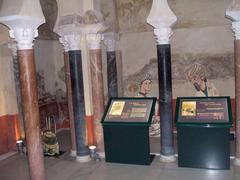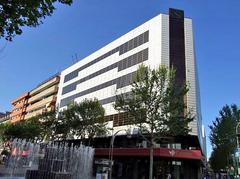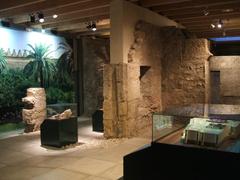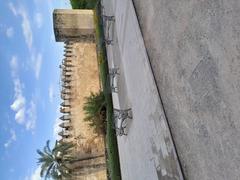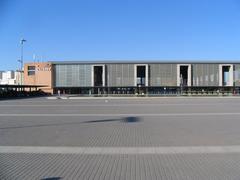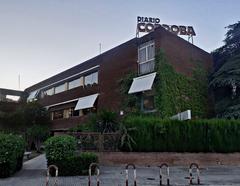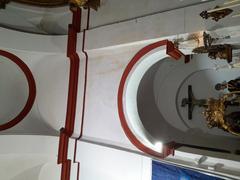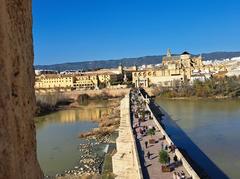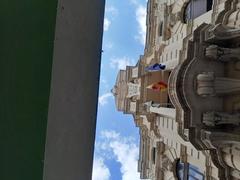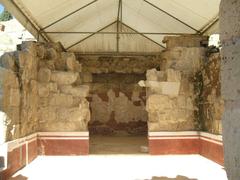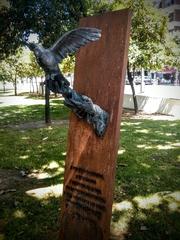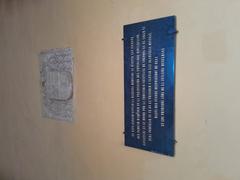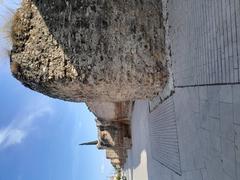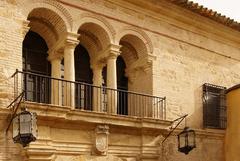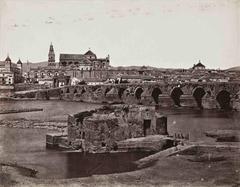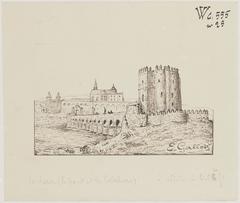Molino de Casillas: Visiting Hours, Tickets, and Complete Guide to Córdoba’s Historic Watermill
Date: 14/06/2025
Introduction
Molino de Casillas, situated along the right bank of the Guadalquivir River in Córdoba, Spain, is a significant testament to the city’s industrial and hydraulic heritage. This 19th-century watermill once transformed locally grown wheat into flour and later evolved into a pioneering hydroelectric plant, playing a pivotal role in Córdoba’s modernization. Though no longer in active use, Molino de Casillas stands as a protected cultural landmark, offering insight into the city’s technological advances and social evolution.
This comprehensive guide provides everything you need to know about visiting Molino de Casillas—including its history, architectural highlights, visiting hours, ticket information, accessibility, and tips for integrating it into your Córdoba itinerary.
Table of Contents
- Historical Context and Cultural Significance
- Architectural Features
- Transformation into a Hydroelectric Plant
- Decline, Preservation, and Heritage Status
- Location and Accessibility
- Visiting Hours and Tickets
- Visitor Experience and Practical Tips
- Nearby Attractions
- Frequently Asked Questions (FAQ)
- Summary Table: Key Visitor Information
- Plan Your Visit and Further Information
- References and Official Resources
Historical Context and Cultural Significance
Molino de Casillas is part of a distinguished group of eleven historic mills along the Guadalquivir, reflecting Córdoba’s millennial tradition of hydraulic engineering and industrial adaptation (Dialnet, Diario Córdoba). Originally constructed in the early 19th century as a flour mill, it was strategically positioned to maximize the river’s hydraulic power.
In the late 19th century, Molino de Casillas was converted into one of Córdoba’s first hydroelectric plants, supplying electricity for urban street lighting from 1895 to 1920. This transition marked a significant technological milestone and symbolized the city’s entry into the industrial era.
The mill’s cultural significance is heightened by its proximity to other major Córdoba historical sites, such as the Roman Bridge and Alcázar de los Reyes Cristianos, making it an essential stop for those interested in the technological and social history of the city (Turismo de Córdoba).
Architectural Features
The mill exemplifies robust 19th-century industrial architecture, with thick masonry walls constructed from locally quarried reddish “molinaza” stone. Its design accommodated grinding stones, grain storage, and living quarters, while sophisticated hydraulic channels expertly directed river water to power the mill’s turbines (Arte, Arqueología e Historia).
Remnants of water intakes and turbine housings can still be seen today, offering a tangible link to Córdoba’s tradition of water-powered industry.
Transformation into a Hydroelectric Plant
In 1895, Molino de Casillas underwent a major transformation, becoming the Fábrica de Electricidad de Casillas (Diario Córdoba). Modern turbines and generators were installed, allowing the mill to produce up to 350 horsepower (about 257,600 watts)—enough to illuminate Córdoba’s streets for 25 years (Dialnet).
This adaptation reflects the broader trend in Córdoba of repurposing traditional watermills to meet the growing demand for electricity during Spain’s industrialization.
Decline, Preservation, and Heritage Status
By the mid-20th century, Molino de Casillas fell into disuse as larger, more efficient power stations emerged. Recognizing its historical value, local authorities have since worked to preserve the mill as part of Córdoba’s industrial heritage. Since 2009, Molino de Casillas holds protected status as Andalusian Historical Heritage, with ongoing efforts to maintain and interpret the site for visitors (Dialnet).
Location and Accessibility
Location:
Molino de Casillas is located on the right bank of the Guadalquivir River, near the Puente de Abbas Ibn Firnas, in western Córdoba (Mapcarta). While it sits outside the historic core, the site is accessible by various means:
- On Foot or Bicycle: A 30–40 minute scenic walk or bike ride along the river from the Mezquita-Catedral area.
- Public Transport: City bus lines stop near the Puente de Abbas Ibn Firnas. Check current routes via the Córdoba tourist office.
- Car: Limited parking nearby; suggested to park closer to the city center and walk or use public transport.
Accessibility:
The riverside path is mostly flat and suitable for wheelchairs and strollers, with some uneven sections. The terrain around the mill itself can be overgrown and may limit access for those with mobility challenges. No restrooms or cafés are available on-site.
Visiting Hours and Tickets
Exterior Access:
Molino de Casillas is primarily an open-air heritage site. The exterior is free to visit and accessible at any time.
Interior Access:
The interior is generally closed, except during special heritage events or guided tours organized by local authorities. For updates on interior access and tour schedules, consult the Córdoba tourism website.
Tickets:
Visiting the exterior is always free. Special events or guided tours may charge a modest fee; advance booking is advised due to limited capacity.
Visitor Experience and Practical Tips
What to See
- Exterior Views: The well-preserved structure and water intake remnants offer excellent photo opportunities, especially at sunset.
- Interpretive Panels: Onsite signage in Spanish provides historical context and highlights the mill’s role in Córdoba’s industrial evolution.
- Surroundings: The adjacent Los Sotos de la Albolafia nature area is ideal for birdwatching, river walks, and relaxation.
Best Times to Visit
- Season: Spring (March–May) and autumn (September–November) for mild weather. Summers can be extremely hot—visit early or late in the day (The Crazy Tourist).
- Lighting: Late afternoon or sunset provides the best photography conditions.
Safety and Etiquette
- Exercise caution near the riverbank, especially after rain.
- Respect the heritage site—do not climb or disturb the structure.
Amenities
- No toilets, cafés, or shops on-site; services are available in nearby neighborhoods or Córdoba’s city center.
Nearby Attractions
- Molino de la Alegría: Houses the Museum of Paleobotany, with regular visiting hours (Oway Tours).
- Molino de Martos: Upstream, home to the Hydraulic Museum and interactive exhibits.
- Córdoba Historic Center: UNESCO World Heritage area within walking or cycling distance, featuring the Mezquita-Catedral, Alcázar de los Reyes Cristianos, and Roman Bridge (The Crazy Tourist).
Frequently Asked Questions (FAQ)
Q: Are tickets required to visit Molino de Casillas?
A: No, access to the exterior is free and open at all times. Interior visits are rare and usually part of special events or guided tours.
Q: What are the visiting hours?
A: The site is an open-air heritage location with no official opening hours. Visitors can explore the exterior anytime.
Q: Is the site wheelchair accessible?
A: The riverside path is generally flat and accessible, though some uneven sections exist. The terrain around the mill may be challenging.
Q: Are guided tours available?
A: Yes, occasionally through local tour operators or during heritage events. Check with the Córdoba tourist office for current offerings.
Q: What is the best time of year to visit?
A: Spring and autumn offer the most pleasant weather conditions.
Summary Table: Key Visitor Information
| Feature | Details |
|---|---|
| Location | Right bank of Guadalquivir, near Puente de Abbas Ibn Firnas |
| Access and Tickets | Free exterior access; no regular interior visits |
| Visiting Hours | Open-air site accessible at all times |
| Guided Tours | Occasionally available; check tourist office |
| Facilities | None on-site; amenities in nearby neighborhoods |
| Best Time to Visit | Spring or autumn; early morning/late afternoon in summer |
| Accessibility | Flat riverside path; some uneven terrain near the mill |
| Nearby Attractions | Other historic mills, Puente de Abbas Ibn Firnas, Córdoba’s historic center |
| Heritage Status | Andalusian Historical Heritage site since 2009 |
Plan Your Visit and Further Information
For the most up-to-date information on access, guided tours, and special events, contact the Córdoba Visitors Centre at Plaza de las Tendillas or visit the official Córdoba tourism website. Downloadable maps and mobile apps are available to enhance your visit.
Travel Tip:
Integrate Molino de Casillas into a wider exploration of Córdoba’s river mills via the “Ruta de los Molinos del Guadalquivir,” a walking or cycling route linking the city’s historic mills (Oway Tours).
References and Official Resources
- Molino de Casillas: Visiting Hours, Tickets, and History of Córdoba’s Historic Watermill (Diario Córdoba)
- Dialnet Article on Molino de Casillas (Dialnet)
- Turismo de Córdoba Official Tourist Offices (Turismo de Córdoba)
- Academia.edu Research on Guadalquivir River Mills (Academia.edu)
- La Guía GO Córdoba: Ruta de los Molinos (La Guía GO Córdoba)
Final Tips
Molino de Casillas is a powerful symbol of Córdoba’s journey from agrarian tradition to industrial innovation. While regular public access is limited, the site’s preserved exterior, riverside setting, and interpretive panels offer a rewarding experience for history and architecture enthusiasts. For a deeper understanding, plan your visit during heritage events or guided tours, and complement your exploration with other historic mills and Córdoba’s renowned monuments.
Stay informed through the official tourism portal and consider using resources like the Audiala app for self-guided tours and up-to-date information.
